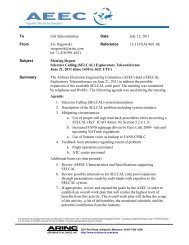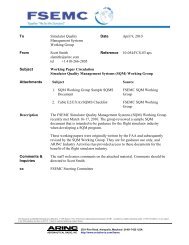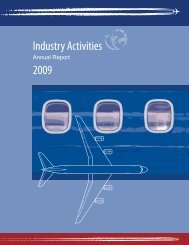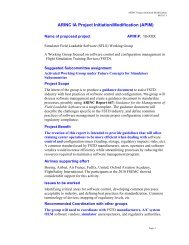(AGIE) Using Internet Protocols - Aviation Committees - AEEC - AMC
(AGIE) Using Internet Protocols - Aviation Committees - AEEC - AMC
(AGIE) Using Internet Protocols - Aviation Committees - AEEC - AMC
- No tags were found...
Create successful ePaper yourself
Turn your PDF publications into a flip-book with our unique Google optimized e-Paper software.
ARINC PROJECT PAPER 830 – Page 213.0 <strong>AGIE</strong> OVERVIEW1. The set of all clients and servers is known at all times to the Primary Serverand admin.2. The network topology between all <strong>AGIE</strong> servers is static, i.e., all nodes arepre-defined, fixed connectivity is known, and the limits on dynamicassociations and connections are bounded.COMMENTARYThe term “Primary” or “Primary Server” is a logical definition which may beimplemented as a single physical server or multiple federated servers.In this closed system the relationship between all servers is static in the sense thatall servers are known, all fixed connections are known, and dynamic connectionsare bounded. Association of clients to hosts is dynamic, such that any client canassociate or un-associate with any server (as bounded by system administration) atany time. To assure full addressing capability is maintained, hosts make all newassociations visible to the <strong>AGIE</strong> Name Service (ANS) and thus to all other nodes inthe system as described in Section 4.5.All clients are uniquely identifiable within the system. In the event more than oneinstantiation of a Client ID attempts to associate with a server, they are providedwith unique identifications or denied association. Typical examples are EFBs orcredit card authorization devices. See Section 4.5.It is necessary to amend the static system configuration from time to time. Suchchanges require a managed effort controlled by authorized system administrators.They are globally visible across the system. <strong>AGIE</strong> defines configuration controlmethods and messages for this purpose in Section 6.0.Part of the <strong>AGIE</strong> definition includes limitations of which clients other clients areallowed to see. This is accomplished by administrators setting a “visible client list”for each client and setting client visibility policies.<strong>AGIE</strong> provides for managing global system configuration and distributing thisinformation to all system nodes. For simplicity, the <strong>AGIE</strong> standard assumes thisinformation is centrally managed on the ground-based Primary knowledge store(Primary), which also hosts the root level <strong>AGIE</strong> Name Server.<strong>AGIE</strong> nodes may inquire about the status of other nodes. <strong>AGIE</strong> servers may alsorequest the status of <strong>AGIE</strong> databases from Primary server at any time. Whereredundant, distributed ANS is used, they are kept synchronized. In the case wheremore than one server exists on an aircraft, one of these servers is defined as thelocal primary. All <strong>AGIE</strong> servers know how to reach an ANS and other Primaryfunctions. ANS provides the translation of <strong>AGIE</strong> node identifiers to addresses andprovides path quality information.3.6.2 Connection Management<strong>AGIE</strong> is an application level (Layer 7) service. All <strong>AGIE</strong> connections are logicalconnections and not physical communication links and for that reason one <strong>AGIE</strong>entity is said to be “associated” with another <strong>AGIE</strong> entity on an application level.Within <strong>AGIE</strong> two types of connections exist. First are connections between clientsand servers; second are connections between two <strong>AGIE</strong> servers. The initiation ofconnection establishment is subject to the following rules/conventions which arestrictly adhered to:










